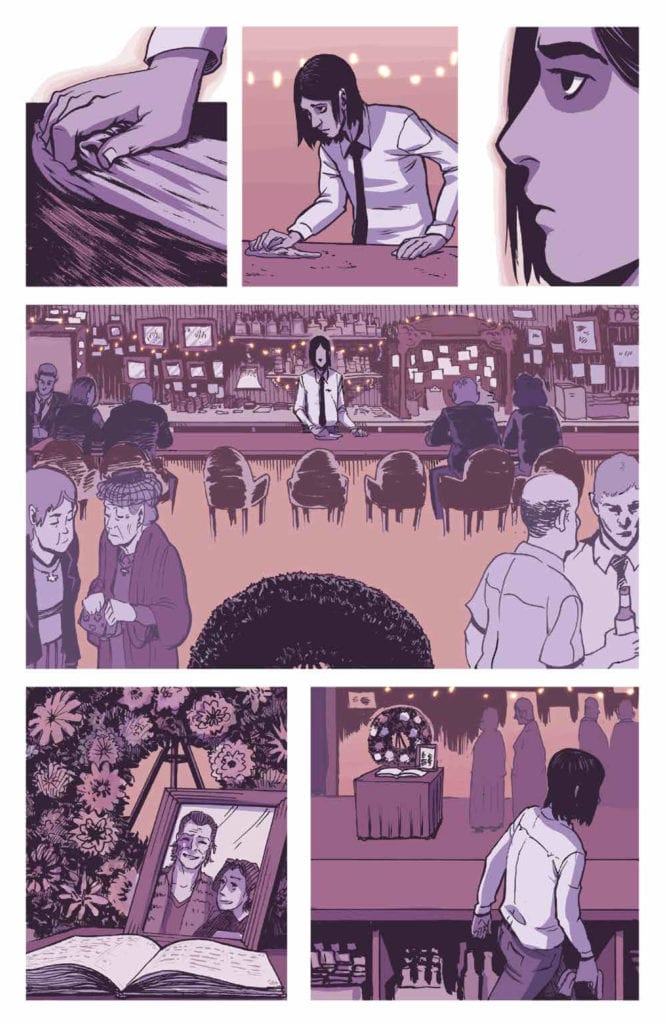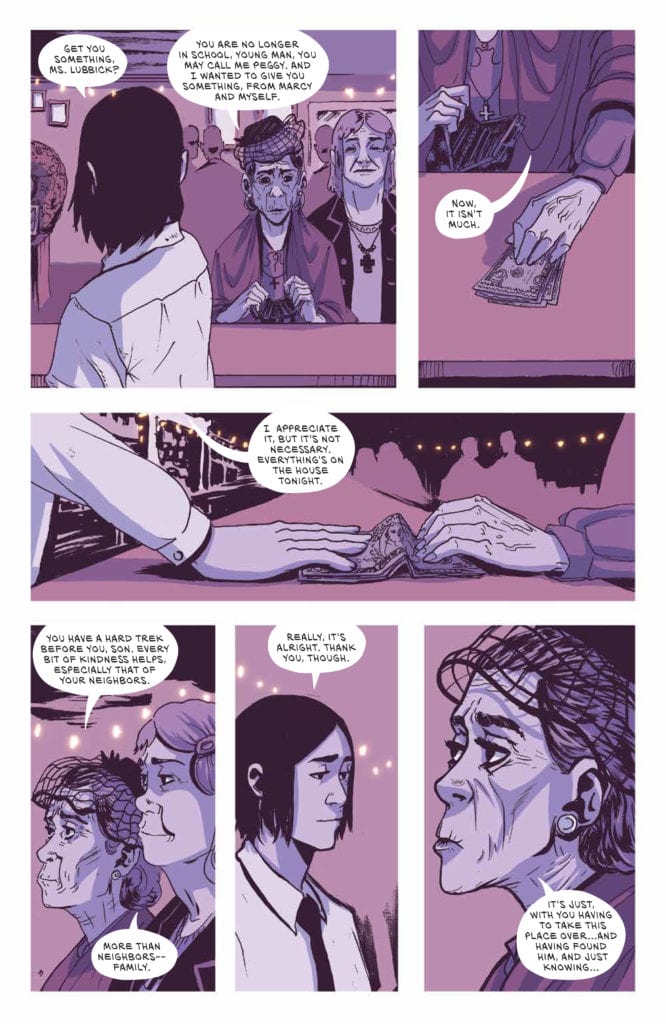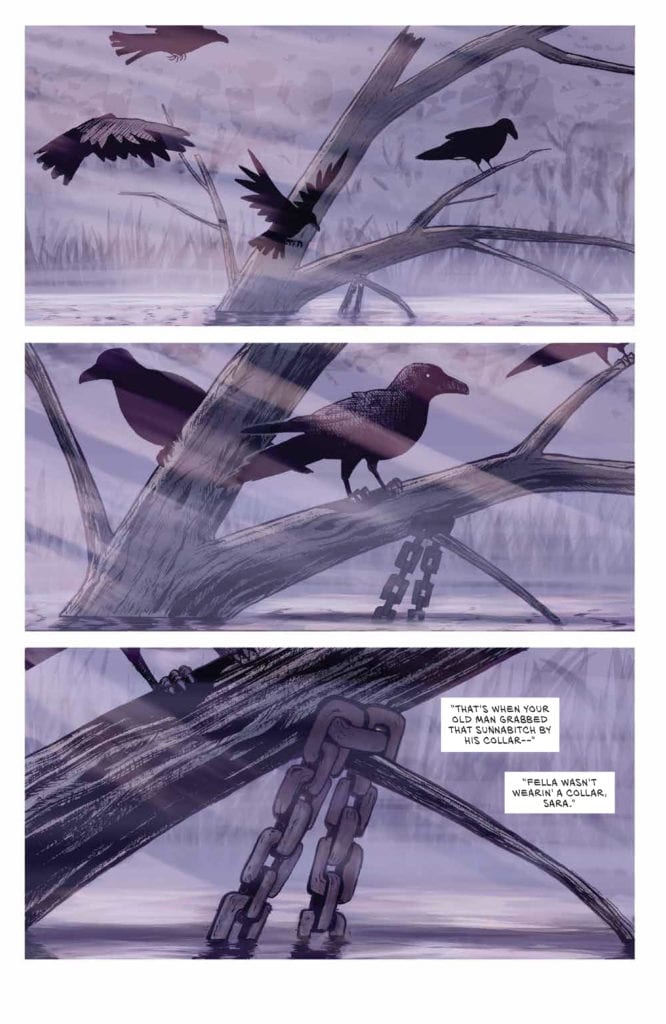For a tale that takes a twist into unsettling waters, The Down River People from Archaia is an enthralling and moving story. Through the antagonist’s journey, Adam Smith and Matthew Fox are able to touch the reader’s heart while playing with modern horror tropes.
Smith and Fox use the long format of the graphic novel and create an undulating rhythm in the narrative that spreads across 13 uneven chapters. It touches on family loss, family reunion, police brutality, honor, and tradition. And through it, all Myers, the central character, has to deal with the growing depression within himself. It is a comic with many levels, and as a reader, you will have the urge to rip away at them to get to the end. However, Smith and Fox constantly slow you down and force you to experience the comic at their speed.

On the Bank
The opening three pages, which are almost wordless, set the scene beautifully for the rest of the book. Fox slowly introduces you to the world of The Down River People, swooping you in like one of the birds depicted in panels. The sequence also highlights one of the main features of Fox’s design for this book; minimalist mise en scene. The scenery is expressively rendered but always at a distance, a beauty to behold but not encountered. This contrasts Myers’ home and his life, where the sets are as simple as the flatbed trailer bar, and the props are sparse. There is a strong focus on two aspects of Myers’ life within the opening chapters, and almost all of the props guide the reader to these two things: alcohol and music.
Fox’s artwork is lyrical and focuses on the details; the wrinkles on an old man’s face, a close-up of a family photograph, or the constant reference to drinking through images of glasses and bottles. Myers’ life is soaked in the business of buying and selling alcohol. This appears to be his world but is it only because it was inherited from his father, Darnell? There is an emptiness to Myers’ life when we are first introduced to him, and this comes across superbly thanks to Fox’s manipulation of the world we see. This emptiness is explored in the narrative as Smith slowly reveals the details of Darnell’s death and the reappearance of Myer’s estranged mother. The book’s first half is an emotional toil for Myers, illustrated by constant drowning imagery as the antagonist is metaphorically pulled out of his depth.

Into the River
Some of the greatest horror films have slow build-ups that could be mistaken for a slice of life drama. Films like Audition by Takashi Miike, Midsommar by Ari Aster, and Nicolas Roeg’s seminal 1973 movie Don’t Look Now, all ease the viewer into a world before tearing it apart. The Down River People follows the same pattern of storytelling and is able to do so because of the graphic novel format. Smith and Fox build an encompassing, realistic world full of grief and cruelty over the space of 200 plus pages. The mundane, day-to-day life that Myers lives, despite his father’s death, is central to the opening chapters, leading the reader to believe that the plot could go down the ‘man against the system’ route. But there are hints that something else is coming and when the narrative shifts, the disturbing horror takes hold.
The horrific element of The Down River People is not of the slasher fair or grotesque demonic nature; it stems from a disturbing cult and the power the leaders have over people. Myers’ journey is about becoming dislodged from his life, and this leaves him susceptible to outside influence. The cult becomes a metaphor for the unstable and insecure world that has been born in recent years. The anxieties and paranoia that have spread through social media and even infiltrated legitimate news companies are repurposed here into a hierarchy of worship. Power is used to manipulate the weak, and the creepy mandate of love, which is used to cover the cruelty, makes your skin crawl more than any deformed, monstrous beast will ever do.

Style and substance
The pacing of the narrative and the page layouts draw you in and control your path through the book so that it becomes nearly impossible to put down. Even as the disturbing elements begin to emerge, the creators have you transfixed like one of the cult members. Part of the charm is the poetic nature of the art/text combination that elevates the experience by creating a magical-realist world—a place of wonder even when in disorder.
The devil is in the details, and The Down River People pays close attention to those details. Fox’s artwork is carefully crafted to draw the reader’s attention exactly where it needs to be. This is helped significantly by Mike Fiorentino’s lettering. The lack of harsh black lines around the speech balloons allows the text to sit within the image much better. It becomes a part of the scene. It also allows for greater emphasis within the speech itself. A word in bold stands out against the whiteness of the balloon.
The color works in much the same fashion as the lettering. Fox’s simplified color washes create a tone and a sense of location but do not overpower a scene. The color provides the backdrop for a page while the panels let the characters come through and be noticed. At times the colors create an idyllic, peaceful environment for cast interaction; at other times, there is a coldness that fuels the conflict in the narrative.

Conclusion
The Down River People is a thoughtful, moving, and then disturbing dreamlike narrative. It is a gripping read from the first chapter, with the creators having complete control over the reader. It is easy to read in a single sitting but demands that you take your time. This will be several hours of your time well spent.
Horror is experiencing a surge at the moment, even infiltrating the Big 2, and comics have a unique position to explore this genre, a visual medium that is to a large degree not constrained by budget requirements. Barry Windsor-Smith has recently returned to the comic world with a monstrous graphic novel packed with grotesquery. In Smith and Fox’s book, a subtler examination of the human spirit is played out with modern horror motifs leading the way. It has a slow build-up but is extremely rewarding at every step of the way.
This book took hold of me like no other comic has this year, and I highly recommend it. It’s for fans of the medium, fans of the genre, and fans of great storytelling. There is a lot to discover in the narrative and the artwork, making you want to re-read before even putting it down for the first time.

